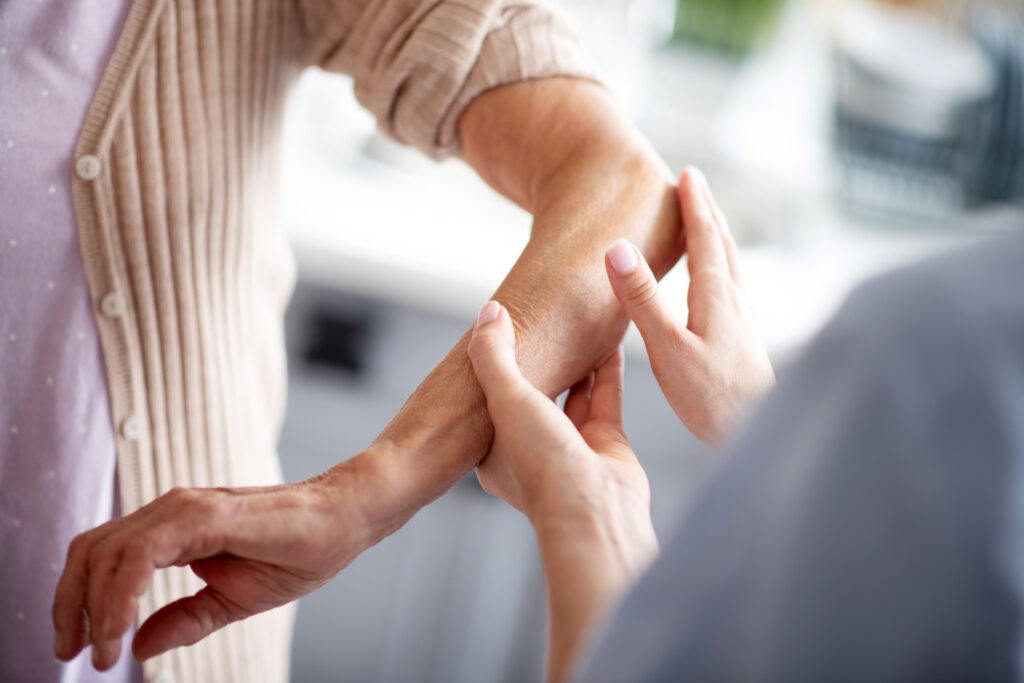If you're grappling with chronic tension headaches, you might be surprised to learn that relief often lies in simple lifestyle adjustments. You could start by examining your posture, hydration levels, and daily activities. Incorporating relaxation techniques and understanding your personal triggers can also make a significant difference. But what if there are deeper secrets and alternative therapies that could drastically change your experience? Exploring these options could be the key to breaking the cycle of pain and discomfort you've been facing.
Understanding Chronic Tension Headaches
Chronic tension headaches can feel like an unwelcome companion in your daily life, often lurking just beneath the surface. You might notice tightness or pressure around your forehead, temples, or the back of your head and neck. Unlike migraines, these headaches usually don't cause nausea or sensitivity to light, making them tricky to identify at times. They can last from a few hours to several days, disrupting your routine and making even simple tasks feel exhausting.
Understanding what chronic tension headaches are is essential for managing them effectively. They typically stem from muscle tension in your neck and scalp, often triggered by stress, poor posture, or prolonged periods of screen time. You might find that your head feels heavy or that you experience a dull ache that doesn't seem to go away. Recognizing the difference between tension headaches and other types of headaches can help you navigate your symptoms more effectively.
It's also worth noting that emotional factors play a significant role. Stress, anxiety, and even fatigue can exacerbate these headaches. You might catch yourself clenching your jaw or tensing your shoulders without even realizing it.
Identifying Triggers and Symptoms
To effectively manage your chronic tension headaches, you need to identify what triggers them and recognize the symptoms you experience.
Common triggers can vary from stress and poor posture to certain foods or lack of sleep.
Common Triggers Explained
Identifying the common triggers of tension headaches can be vital for managing and alleviating your symptoms. These headaches often stem from various factors in your daily life, so recognizing them is the first step toward relief.
Stress is a leading culprit; whether it's work pressure, family responsibilities, or financial worries, high-stress levels can lead to tension headaches.
Poor posture also plays a significant role. If you spend long hours at a desk or hunch over your phone, the strain on your neck and shoulders can trigger discomfort. Additionally, eye strain from staring at screens for extended periods can contribute to headaches as well.
Dehydration is another common trigger you might overlook. Not drinking enough water throughout the day can lead to tension and discomfort.
Similarly, lack of sleep or irregular sleep patterns can exacerbate your headaches, making it essential to establish a consistent sleep routine.
Finally, dietary factors, such as skipping meals or consuming excessive caffeine, can also trigger these headaches.
Recognizing Key Symptoms
Recognizing the key symptoms of tension headaches is essential for effective management. By identifying these symptoms early, you can take steps to alleviate discomfort before it escalates.
Here are some common signs to look out for:
- Dull, aching head pain: This is often described as a tightness or pressure around your forehead or the back of your head.
- Tenderness in the scalp or neck: You might notice sensitivity in these areas, which can worsen as the headache progresses.
- Increased sensitivity to light and sound: While not as pronounced as in migraines, you may feel more discomfort in bright lights or loud environments.
Once you recognize these symptoms, you can start tracking when and where they occur. Understanding your headache patterns helps you pinpoint triggers and implement strategies to prevent future episodes.
By being proactive, you can manage your tension headaches more effectively, enhancing your overall well-being.
Lifestyle Changes for Relief
Making simple lifestyle changes can greatly reduce the frequency and intensity of chronic tension headaches.
First, evaluate your daily routine. If you spend long hours hunched over a computer or phone, it's time to adjust your posture. Try to sit up straight and take regular breaks to stretch. Implementing ergonomic furniture can also make a difference in how your body feels throughout the day.
Next, pay attention to your hydration. Dehydration can trigger headaches, so aim to drink plenty of water. Keep a water bottle handy to remind yourself to stay hydrated.
Incorporating balanced meals into your diet is essential as well. Foods rich in magnesium, such as leafy greens, nuts, and whole grains, may help ease tension and prevent headaches.
Sleep is another vital factor. Establishing a regular sleep schedule can improve your overall well-being. Make sure you're getting enough rest each night, ideally around 7-9 hours.
Create a calming bedtime routine and limit screen time before bed to promote better sleep quality.
Lastly, consider your stress levels. Chronic tension headaches often stem from stress. Identify stressors in your life and find ways to manage them.
Whether it's through physical activity, connecting with friends, or setting boundaries at work, addressing stress head-on can lead to significant improvements in your headache symptoms.
Relaxation Techniques to Explore
In addition to lifestyle changes, incorporating relaxation techniques can greatly help in managing chronic tension headaches. These techniques can't only alleviate your headaches but also improve your overall well-being.
Here are some effective methods you might want to explore:
- Deep Breathing: Take a few moments each day to focus on your breath. Inhale deeply through your nose, hold for a few seconds, then exhale slowly through your mouth. This simple practice can calm your mind and reduce muscle tension.
- Progressive Muscle Relaxation (PMR): This technique involves tensing and then relaxing different muscle groups in your body. Start from your toes and work your way up to your head. By consciously relaxing your muscles, you can relieve the physical stress that contributes to headaches.
- Guided Imagery: Visualizing a peaceful scene can help ease your mind. Close your eyes and imagine a place where you feel safe and relaxed, like a beach or a quiet forest. Spend a few minutes here, allowing your worries to drift away.
Integrating these relaxation techniques into your daily routine can create a significant impact on your tension headaches. They're easy to practice and can be done anywhere.
Benefits of Physical Activity
Engaging in regular physical activity can notably reduce muscle tension, helping you feel more relaxed and comfortable.
Not only does exercise relieve physical stress, but it also boosts your mood naturally, making it easier to manage headaches.
Reduces Muscle Tension
Regular physical activity plays an essential role in reducing muscle tension, which is often a significant contributor to chronic tension headaches. Engaging in consistent exercise helps your muscles relax, improves blood circulation, and releases built-up stress.
When you move your body, you're not just working out; you're actively fighting against the tension that can lead to headaches.
Here are some key benefits of reducing muscle tension through physical activity:
- Improved flexibility: Regular stretching and movement help lengthen tight muscles, preventing stiffness and discomfort.
- Enhanced blood flow: Exercise increases circulation, delivering oxygen and nutrients to your muscles, which can help them recover and reduce tension.
- Better posture: Strengthening your core and back muscles through physical activity can improve your posture, minimizing muscle strain that often leads to headaches.
Boosts Mood Naturally
Boosting your mood naturally through physical activity can be a game changer for those suffering from chronic tension headaches. When you engage in regular exercise, your body releases endorphins, the feel-good hormones that elevate your mood and reduce stress. This surge of endorphins helps counteract the tension that often leads to headaches.
You don't need to engage in high-intensity workouts to experience these benefits. Simple activities like walking, stretching, or yoga can greatly enhance your mood. Just 30 minutes a day can make a difference.
Plus, being outdoors can amplify these effects, as fresh air and sunlight contribute to overall well-being.
Incorporating physical activity into your routine also provides a sense of accomplishment, boosting your self-esteem. As you become more active, you'll likely notice improvements in your sleep quality, which is another key factor in headache management.
Better sleep can further reduce tension and anxiety.
Alternative Therapies to Consider
Many people find relief from chronic tension headaches through alternative therapies that target both the physical and emotional aspects of pain. Exploring these options can empower you to take control of your discomfort and improve your overall well-being.
Here are three alternative therapies worth considering:
- Acupuncture: This ancient practice involves inserting thin needles into specific points on the body to promote balance and relieve pain. Many individuals report a reduction in headache frequency and intensity after regular sessions.
- Massage Therapy: A skilled massage therapist can help alleviate muscle tension in your neck, shoulders, and scalp, which often contributes to headaches. Even self-massage techniques can be effective, allowing you to address tight areas as needed.
- Mindfulness and Meditation: Incorporating mindfulness practices into your daily routine can help reduce stress and promote relaxation. Techniques such as deep breathing, guided imagery, or progressive muscle relaxation can bring about a sense of calm, potentially easing headache symptoms.
You might find that combining these therapies offers the best results. For instance, practicing mindfulness before an acupuncture session can enhance its effectiveness.
When to Seek Professional Help
Recognizing when to seek professional help for chronic tension headaches is vital for effective management and relief. If your headaches persist despite trying home remedies or lifestyle changes, it's time to consult a healthcare provider. Chronic tension headaches can be a symptom of underlying issues, and a professional can help identify and address these root causes.
You should also seek help if your headaches are accompanied by other concerning symptoms, such as vision changes, severe nausea, or neurological signs like weakness or numbness. These could indicate more serious conditions that require immediate attention.
Additionally, if your headaches interfere with your daily life, making it difficult to work or enjoy activities, a professional can provide tailored strategies to alleviate your suffering.
If you find yourself relying on over-the-counter medication more frequently than recommended, this could signal a need for medical intervention. Chronic use of pain relievers can lead to rebound headaches, compounding your discomfort. A healthcare provider can suggest alternative treatments or medications that may be more effective and safer.
Finally, don't hesitate to seek help when you feel overwhelmed or anxious about your headaches. Mental health plays a significant role in managing chronic pain, and a professional can offer strategies to help you cope.
Trust your instincts: when something feels off, reaching out for professional support is an important step toward relief and better well-being.
Conclusion
Incorporating these secrets into your daily routine can make a significant difference in managing chronic tension headaches. By understanding your triggers, practicing relaxation techniques, staying active, and exploring alternative therapies, you'll be well-equipped to reduce your symptoms. Remember, consistency is key, and don't hesitate to seek professional help if your headaches persist. Take charge of your well-being, and you might just find the relief you've been searching for!



